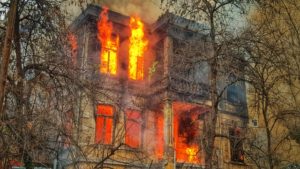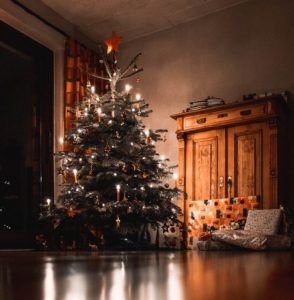A fresh-cut Christmas tree is a source of holiday warmth and cheer in millions of homes all across the country. But every year these trees cause property damage, injuries, and even deaths.
Bringing a living tree into your home automatically creates a serious fire hazard. Avoiding these very real dangers involves carefully selecting, installing, and maintaining your tree. A dry tree is a dangerous tree. Keeping a tree hydrated is the single most important aspect of keeping a tree safe. A dry tree will go up in flames in seconds, while a fully hydrated tree may be unable to catch light at all.

How to keep your Christmas tree hydrated
- Pick the right tree. A recently-cut, vibrant, green tree with full needles will live far longer and absorb far more water. Make sure you find a tree that is still alive, without bare branches or brown needles.
- Cut the tree before installation. After a tree is cut the trunk quickly dies and dries out. Cut two inches off the trunk immediately before setting up the tree in your home with a dish of water, and your tree will absorb far more water.
- Water your tree regularly. Your tree will be particularly thirsty in the first twenty-four hours after installation, and may need up to a gallon of water. After that, keep a close eye on the water levels, and make sure the cut end of the trunk is never exposed to the air.

The tree’s installation and surrounding environment are also crucial. Your tree should be placed on a purpose-built stand that provides complete stability. A tree that falls over presents a massively increased fire hazard. It may be tempting to deck your tree with authentic candles or position it close to the fireplace for a postcard Christmas tableau, but your tree should always be kept far away from any potential source of an open flame. However, avoiding pre-existing fire is not always sufficient.
Most Christmas tree fires are caused by an electrical issue. Over-taxed outlets, broken lights, long extension cords, and poor light selection can all cause an ignition. Lights are an intrinsic part of the holiday season, but not all are designed for indoor use on a tree. Lights intended for outdoor use are far stronger and brighter. Using these lights on a tree, in close proximity to the needles, can cause overheating and spark a flame.
Finally, make sure to always turn the tree’s lights off before you go bed. Leaving lights on overnight not only creates an increased hazard, but a fire in the middle of the night is far more dangerous to the home’s inhabitants.
If you or a loved one have been injured in a fire through no fault of your own, you can discuss your unique situation with Allen & Allen via a free consultation. Call today at 866-388-1307.




